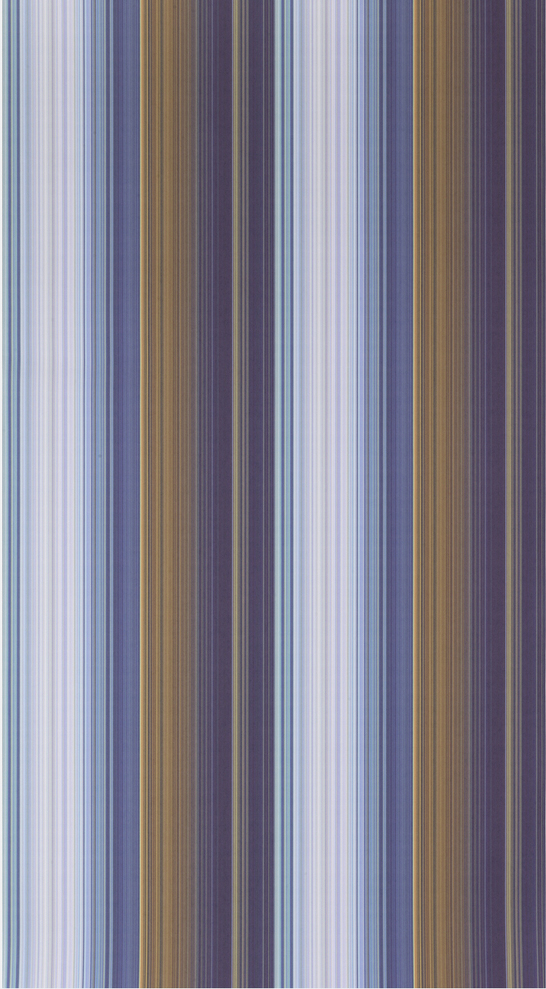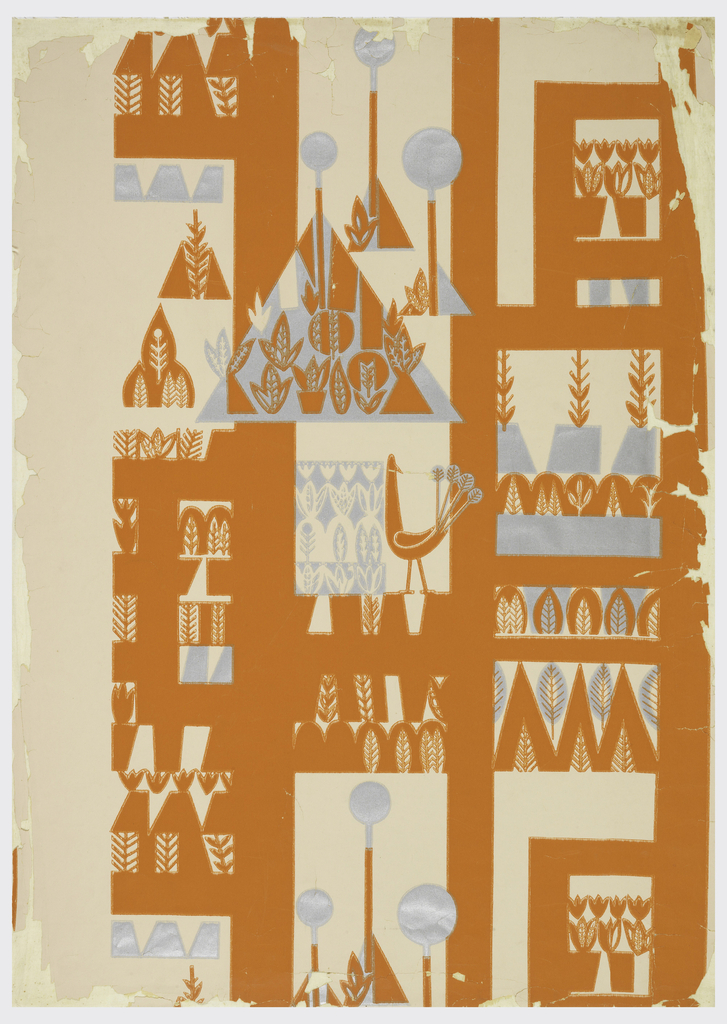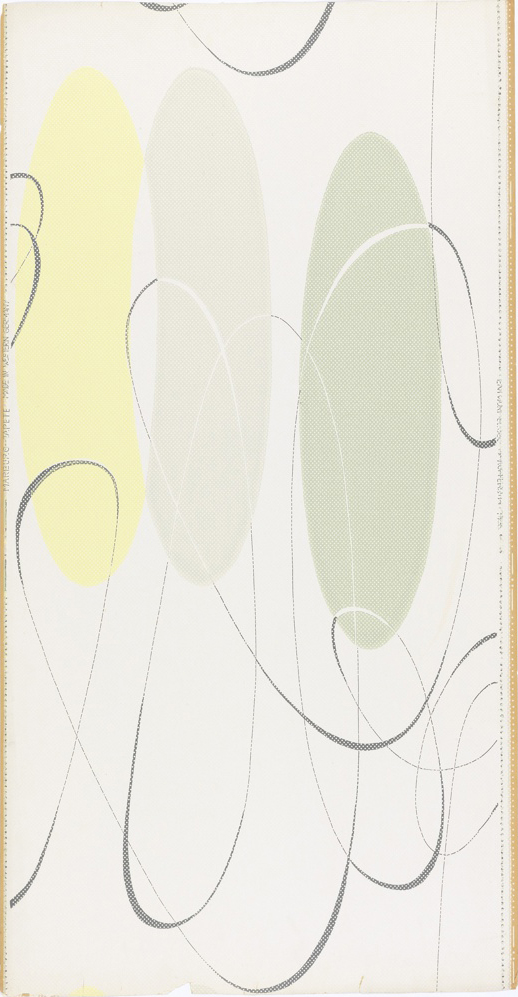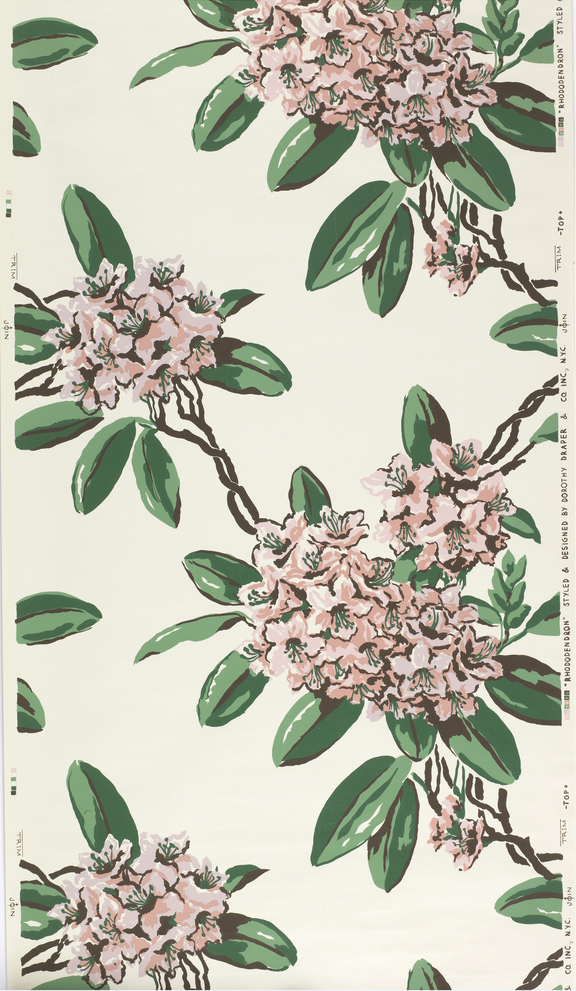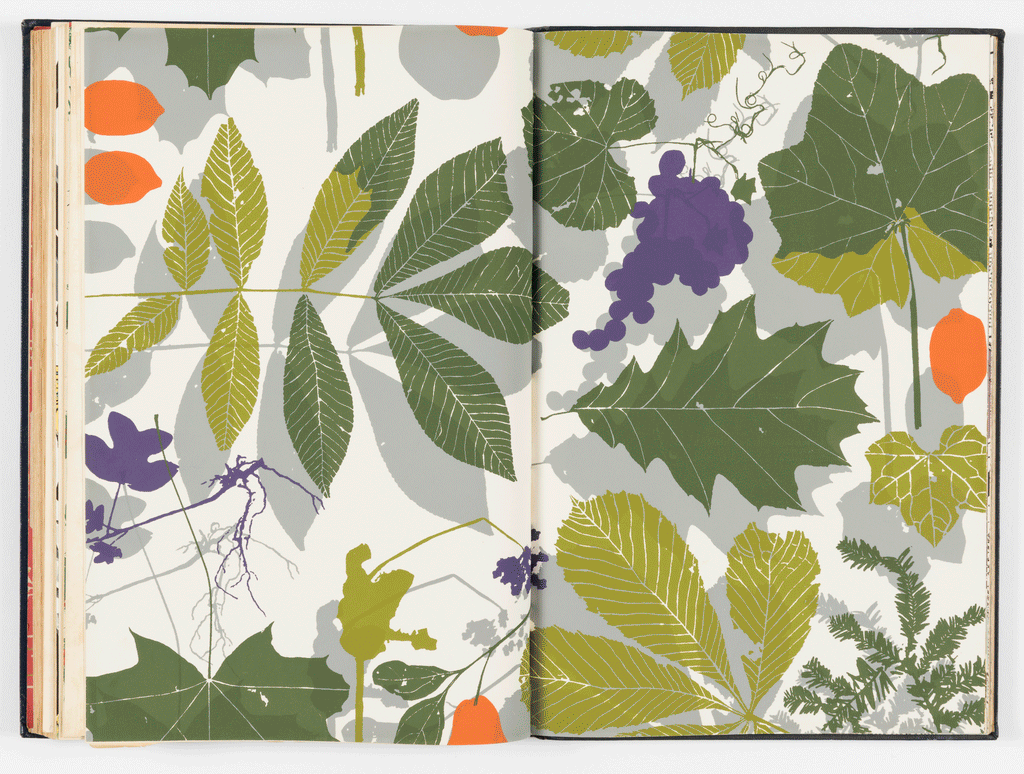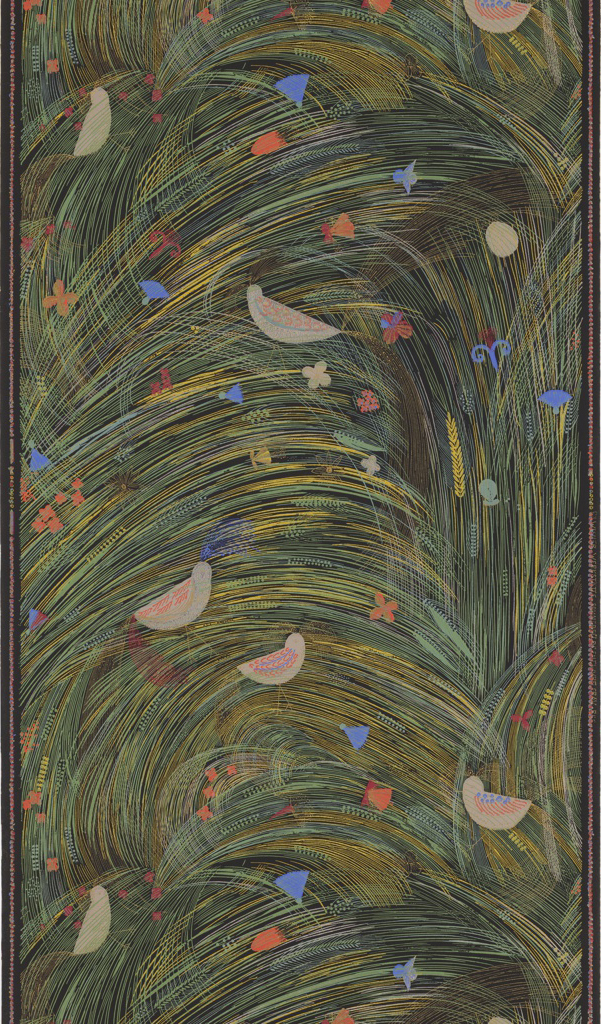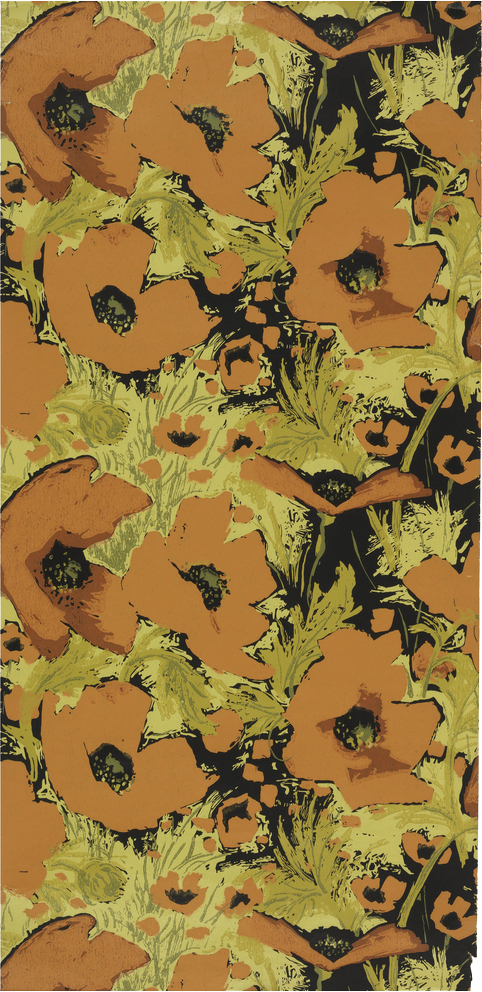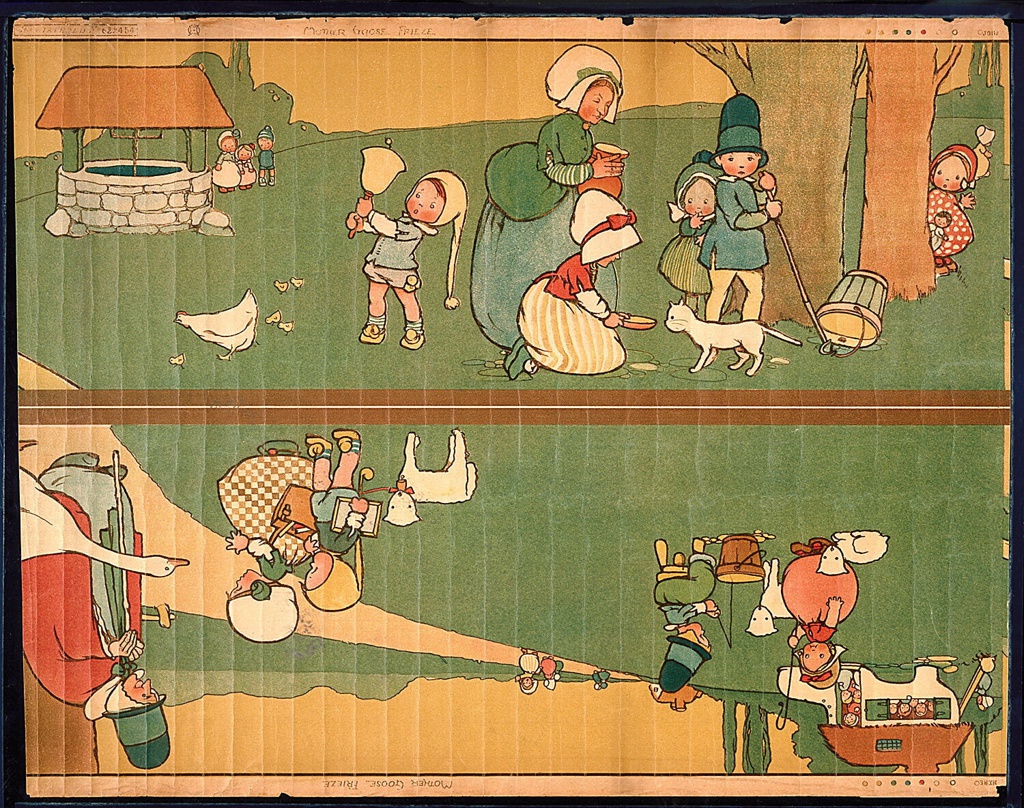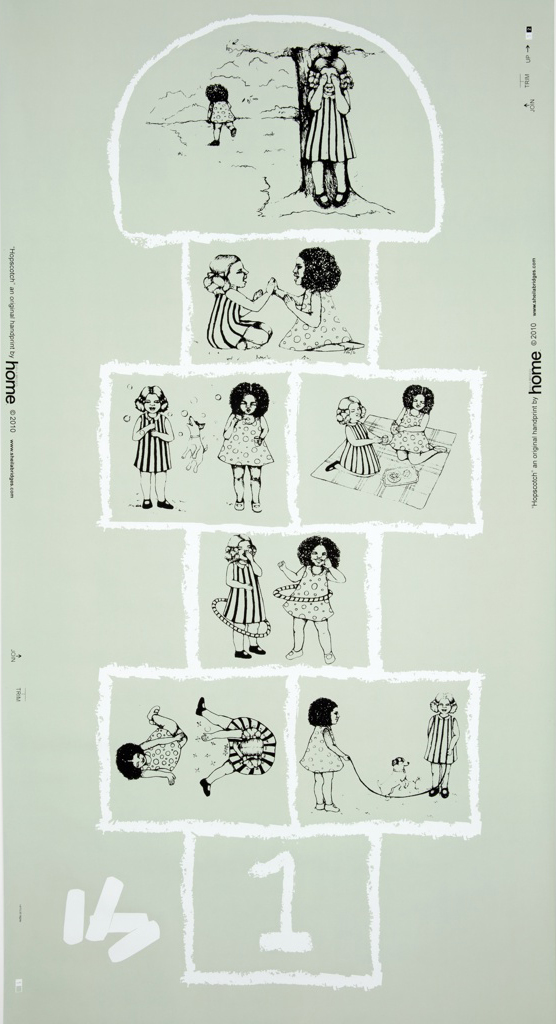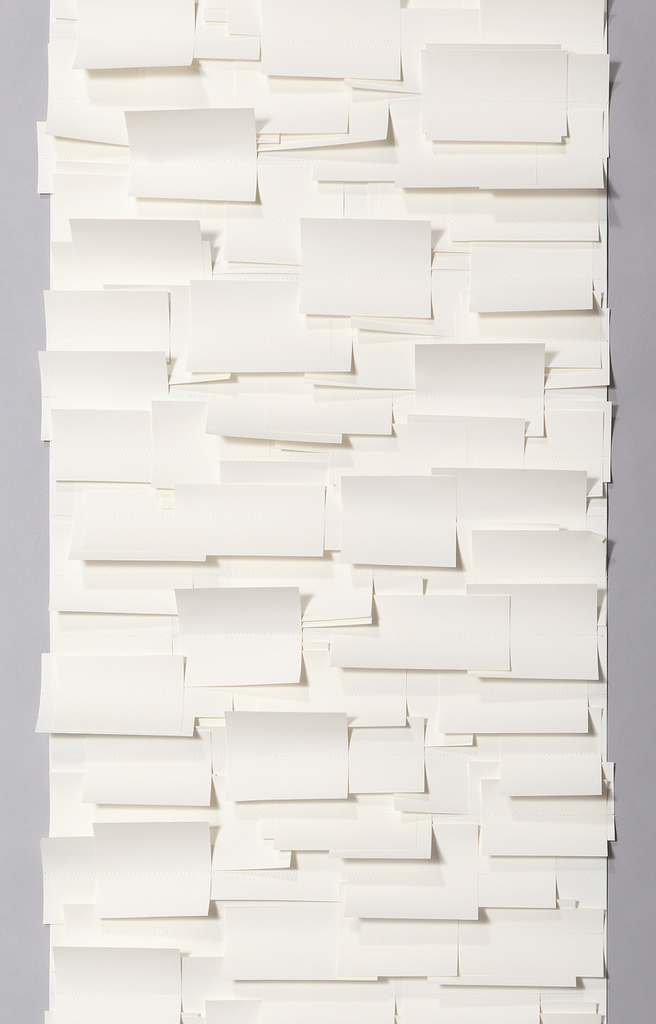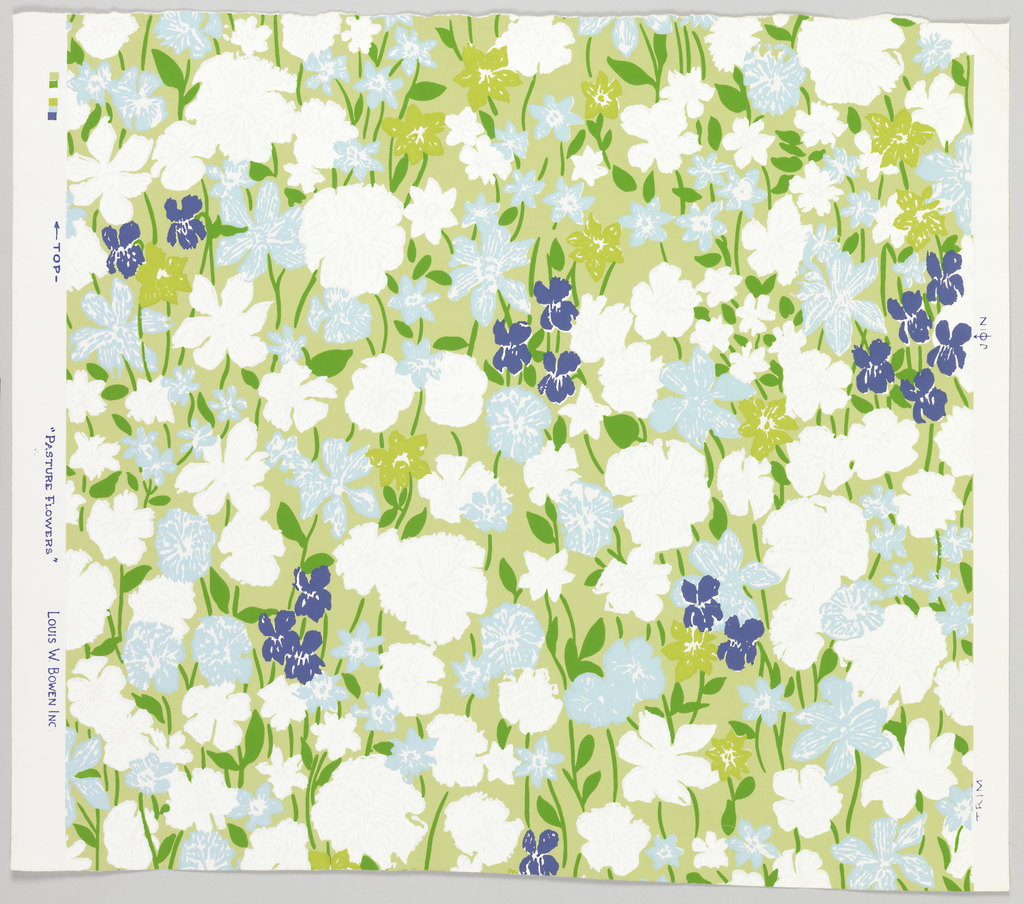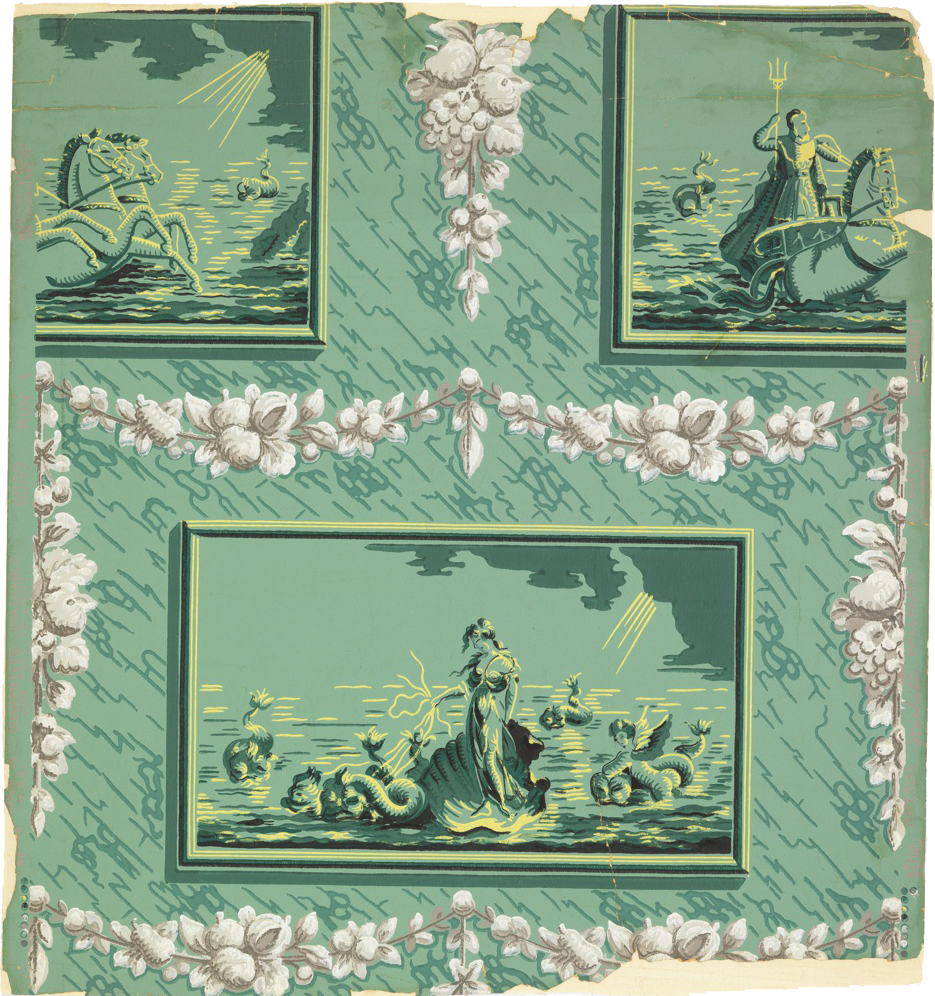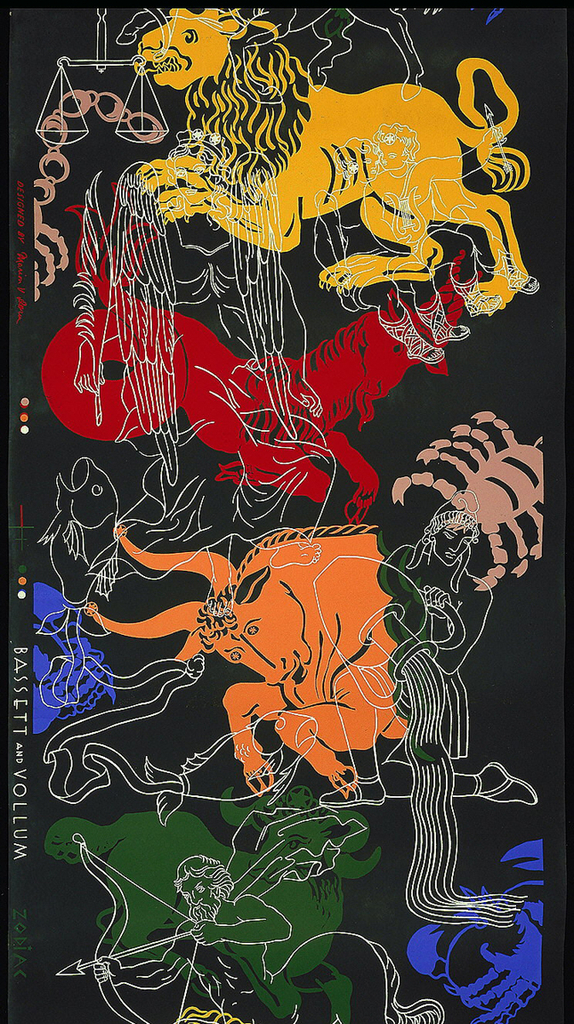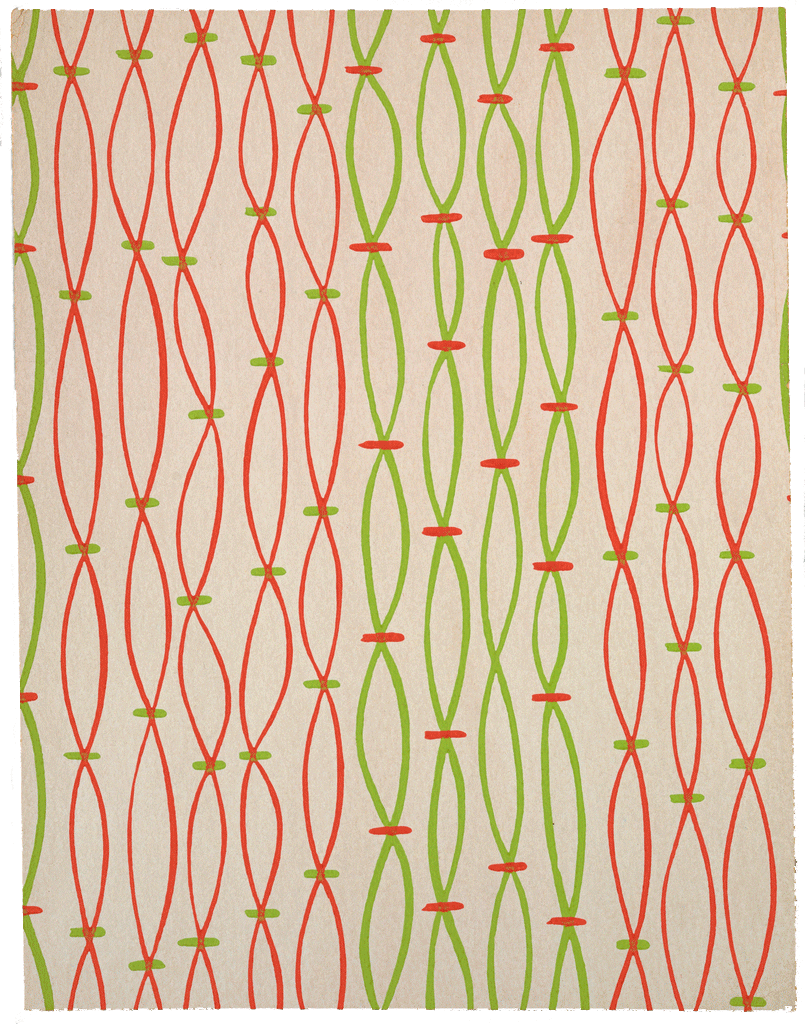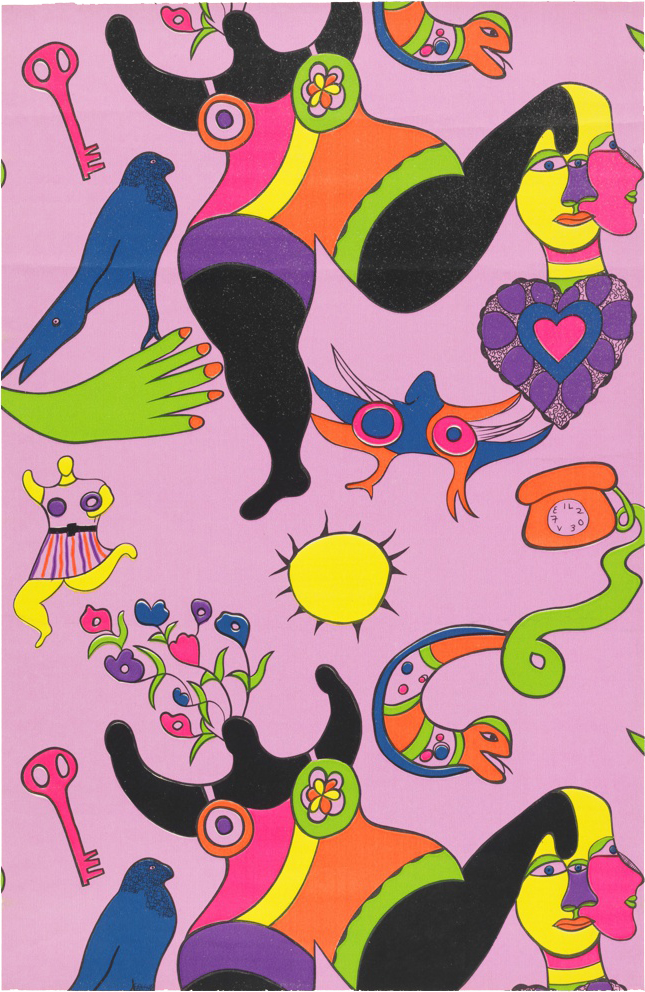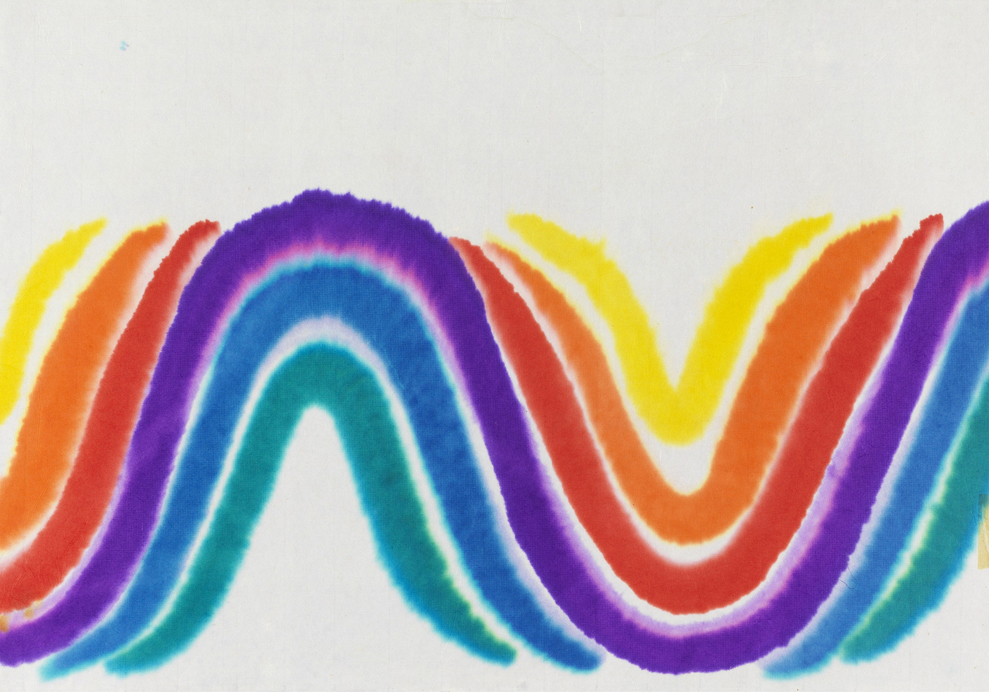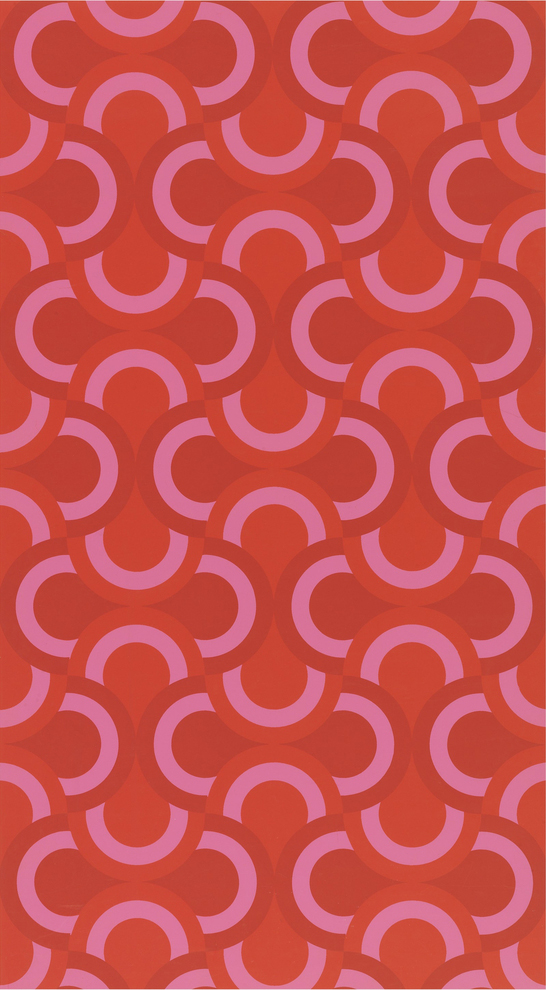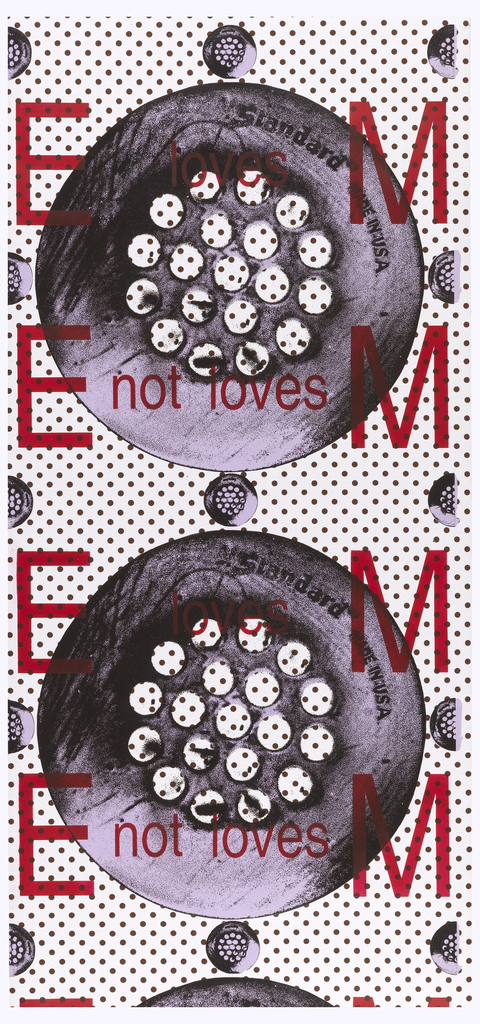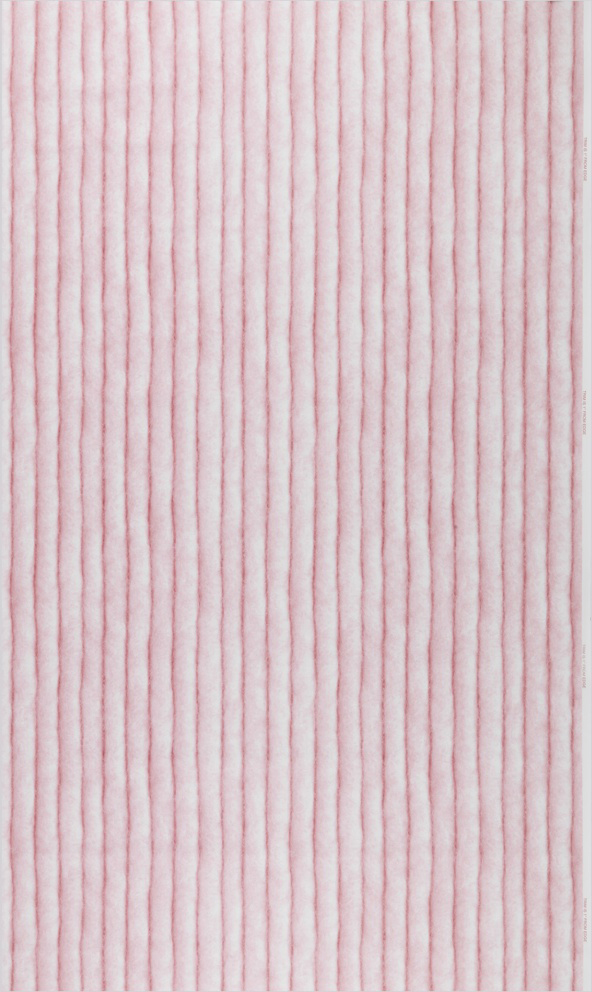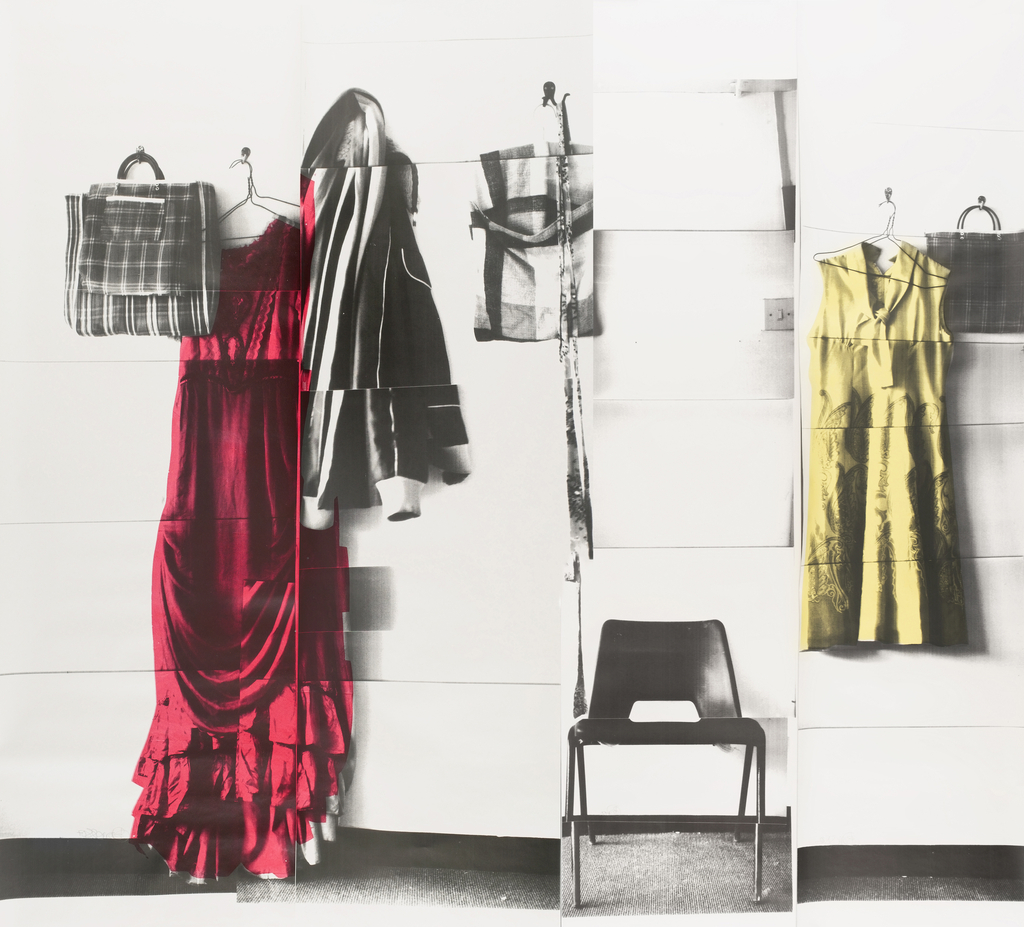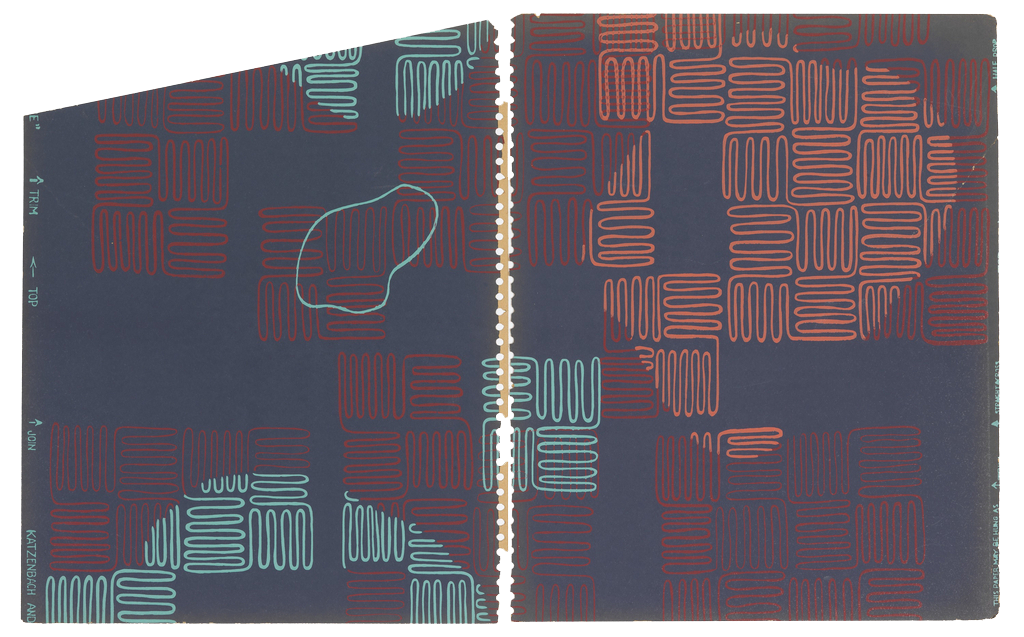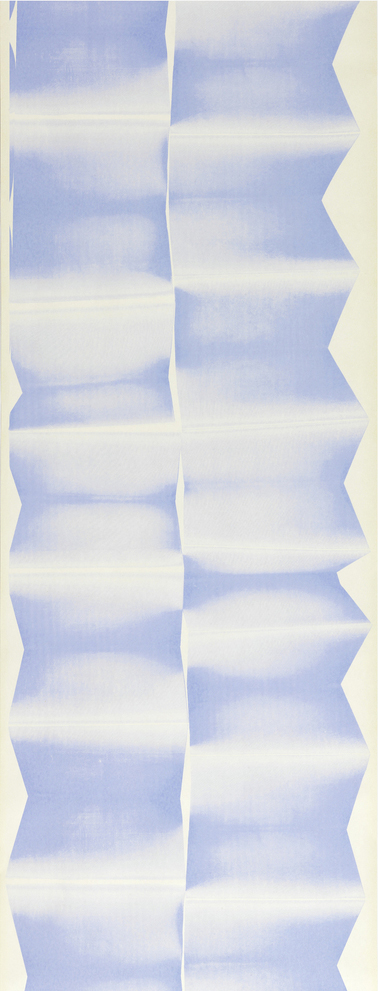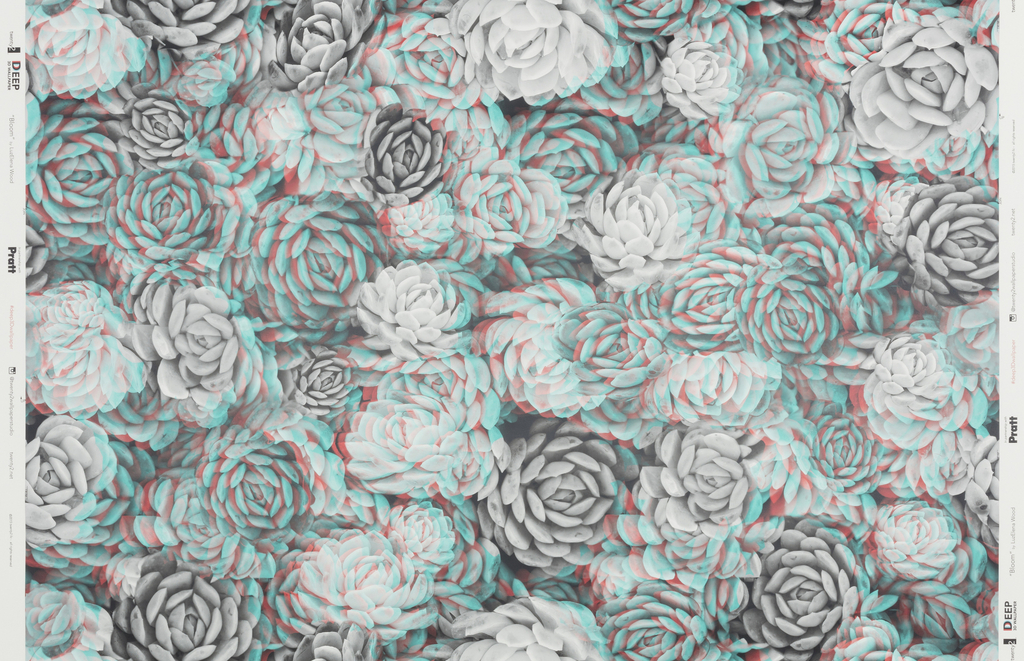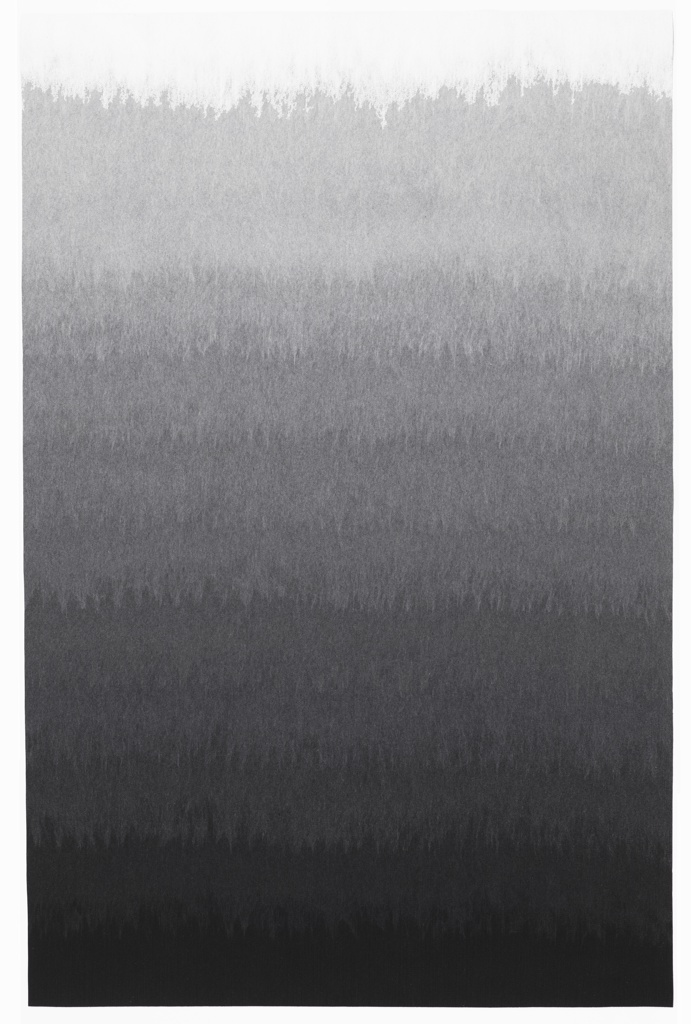Designers of wallpapers respond to trends across design disciplines, particularly interior decorating. Women have adapted design trends and styles into this specific medium and have also found imaginative ways to enliven walls and interiors. Explore more than 100 years of wallpaper design by women.
Irma Boom
Sidewall, t.e.124, 2012
Designed by Irma Boom (Dutch, born 1960)
Made by Eijffinger (Dutch, born 1875, The Hague, Netherlands)
Digital print on non-woven paper
901.7 × 74.9 cm (29 ft. 7 in. × 29 ½ in.)
Gift of Thomas Eyck, 2012-33-1
This striped wallpaper is one pattern from a group of seven which form Irma Boom’s Colour-Based on Nature collection. Working from photographs of UNESCO/World Heritage Sites around the globe, Boom has translated each of the landscapes into a digital color diagram. The diagrams were then translated into striped wallpaper patterns and specially mixed colors were created for each of the different palettes.
—Gregory Herringshaw, “Eruption of Color” (Cooper Hewitt, 2015)
Mathilde Flögl
Sidewall, 1900–1920
Possibly by Mathilde Flögl (Austrian, born Czech Republic, 1893–1950)
Machine-printed paper
90 × 64 cm (35 7/16 × 25 3/16 in.)
Gift of Dr. Francis J. Geck, 1980-73-25
Mathilde Flögl, who likely created this paper, was one of the more prolific contributors to the Wiener Werkstätte, the Viennese craft community that operated from 1903 to 1932. Her output included designs for wallpapers, textiles, posters, leatherwork, book design, glass, and ceramics. She was one of a large group of women craftsmen, including Felice Rix-Ueno, Vally Wieselthier, and Maria Likarz-Strauss, who joined the workshop beginning in the 1910s.
—Nicholas Lopes, “Werkstätte Whimsy” (Cooper Hewitt, 2018)
See more work by Mathilde Flögl in Cooper Hewitt’s collection.
Elsbeth Kupferoth
Sidewall, 1950–56
Designed by Elsbeth Kupferoth (German, born 1920)
Made by Marburger Tapetenfabrik (Germany)
Machine-printed paper
107.5 × 56 cm (42 5/16 × 22 1/16 in.)
Gift of Marburger Tapetenfabrik, 1957-116-8
This sidewall, produced by Marburger Tapetenfabrik circa 1950–56, is demonstrative of Kupferoth’s aptitude in creating the contemporary abstract patterns that were a favorite of many mid-century German designers. Wallpapers of this aesthetic were popularly hung in new homes erected during the postwar building booms of Western Europe and the United States.
—Anna Rasche, “An Abstract by Kupferoth” (Cooper Hewitt, 2016)
Dorothy Draper
Sidewall, Rhododendren, 1973
Designed by Dorothy Draper (American, 1889–1969)
Made by Dorothy Draper & Co., Inc. (New York, New York, USA)
Screen printed on paper
198 × 76.5 cm (6 ft. 5 15/16 in. × 30 1/8 in.)
Gift of The Greenbrier Hotel, 1979-51-1-a,b
Dorothy Draper is one of the best-known and most-loved decorators of the 20th century. Draper designed the Rhododendron wallpaper for her renovation of the Greenbrier Hotel in White Sulphur Springs, West Virginia, in 1948. The original Greenbrier opened in 1780 and, prior to World War II, was the preferred hotel of the Southern elite. Following its use by the military during the war, the Greenbrier commissioned Draper to decorate the hotel during its $4.2 million renovation. Draper used 15,000 rolls of Rhododendron wallpaper to line the halls.
—Gregory Herringshaw, “Dorothy Draper’s Rhododendron” (Cooper Hewitt, 2012)
Vera Neumann
Sample Book, Encore Selection, 1950–51
Designed by Vera Neumann (American, 1910–1993) and Bent Karlby (Danish, 1912–1998)
Manufactured by F. Schumacher & Co. (New York, New York, USA)
Screen-printed paper
52 × 35.5 cm (20 ½ × 14 in.)
Gift of Mr. and Mrs. William Miller, 1980-71-1-1/116
This wallpaper sample book, attributed to Vera Neumann and Bent Karlby, offers are variety of subjects—from nature to cityscapes to interiors to abstraction—rendered in an illustrative, colorful style.
Felice Rix-Ueno
Sidewall, Sommerfeld, 1917–28
Designed by Felice Rix-Ueno (Austrian, 1893–1967, active Japan 1935–1967)
Made by Salubra-Werke A. G. for Wiener Werkstätte (Vienna, Austria, 1903–1932)
Machine-printed paper
212.1 × 75.2 cm (6 ft. 11 1/2 in. × 29 5/8 in.)
Gift of Mrs. A. H. Jacobs, 1967-14-1-a/f
Rix-Ueno’s paper is unique from other Werkstatte examples in the way the design is centered around large whorls of green and golden grass. The style of the various birds and flowers, done in simple half-circle, clover, and triangle shapes is more commonly seen. Rix-Ueno had a strong connection with Japanese art (she married a Japanese architect Isaburo Ueno in 1925 and later moved to Japan), and perhaps the wallpaper was inspired by Japanese paintings that depicted long-bladed clumps of grass.
—Nicholas Lopes, “A Wild Meadow” (Cooper Hewitt, 2016)
See more of Felice Rix-Ueno’s work in Cooper Hewitt’s collection.
Lanette Scheeline
Sidewall, Giant Poppies, 1966
Designed by Lanette Scheeline (American, 1910–2001)
Manufactured by Katzenbach and Warren, Inc. (New York, New York, USA)
Machine-printed paper
108 × 50.5 cm (42 ½ × 19 7/8 in.)
Gift of Lanette Scheeline, 1998-29-84
This particular paper, though printed by a New York–based company, recalls in its vivid oranges and yellows the heat and intensity of a California summer. Lanette Scheeline, a native of the Bay Area, is best known for the textiles she produced in the 1950s while working in Berkeley and San Francisco, but she was an equally prolific wallpaper designer.
—Nicholas Lopes, “California Gleamin’” (Cooper Hewitt, 2018)
See more of Lanette Scheeline’s work in Cooper Hewitt’s collection.
Mabel Lucie Attwell
Frieze, Mother Goose, 1913
Mabel Lucie Attwell (British, 1879–1964)
Manufactured by C. and J. G. Potter (England)
Machine printed with engraved rollers
70.5 × 56 cm (27 3/4 × 22 1/16in.)
Gift of Philadelphia Museum of Art, 1971-58-52
Attwell illustrated many children’s books and was known for her depiction of children and infants. This adaptation of Mother Goose was likely designed for a nursery.
Sheila Bridges
Sidewall, Hopscotch, 2011
Designed by Sheila Bridges (American, born 1964)
Manufactured by Sheila Bridges Home
Printed by Barnaby Prints
Ink on coated paper
Repeat H × W: 152.4 × 68.6 cm (60 × 27 in.)
Gift of Sheila Bridges, 2021-18-1
Adapting the visual format of one of the oldest and most popular children’s sidewalk games, Hopscotch harnesses the magic and innocence of childhood nostalgia to create a powerful wall design projecting the ideal of a race-blind world. Instead of being numbered, each of the eight chalk-drawn hopscotch squares—with the exception of the first one—features a vignette of two young girls, one Black and one white, engaged in an outdoor game or activity that children have been playing for generations, such as hide-and-seek, jump rope, and hula hoops.
—Yao-Fen You (Cooper Hewitt records)
Tracy Kendall
Sidewall, In the White Room, 2008
Designed by Tracy Kendall (British, n.d.)
Cut and sewn paper on paper support
371.3 × 55 cm (12 ft. 2 3/16 in. × 21 5/8 in.)
Gift of Tracy Kendall, 2008-11-1
In the White Room is intentionally devoid of color in order to focus the eye on the textural quality of the design. The haphazard arrangement of overlapping sheets, which are cut to different sizes, results in some sheets curling more than others, enhancing the depth of the wallcovering. There is a linear visual consistency due to the regulated rows of stitches holding the sheets in place, but the open mosaic of curled sheets creates movement and invites a dramatic play of light and shadow.
—Andrea Lipps, “Wallpaper, in 3-D” (Cooper Hewitt, 2012)
Phoebe Hyde
Sidewall, Pasture Flowers, 1960–66
Designed by Phoebe Hyde (American, 1917–1967)
Made by Louis W. Bowen, Inc. (American, 1914–2002)
Screen-printed on paper
75 × 66 cm (29 ½ × 26 in.)
Gift of Mrs. Kolbert Leonard, 1967-80-2-a/f
Cooper Hewitt owns nearly two dozen wallpaper designs by Hyde, all featuring flower or plants themes. This sample takes a slightly more abstract approach to traditional florals, offering fewer details in favor of planes of color, and embraces a more acidic color palette of the late 1960s and ‘70s.
See more wallpapers by Phoebe Hyde.
Teresa Kilham
Sidewall, Mythology, 1938
Designed by Teresa Kilham (American, born 1908)
Made by Imperial Wallcoverings Inc. (New York, USA)
Machine-printed paper
58 × 50 cm (22 13/16 × 19 11/16 in.)
Gift of Teresa Kilham, 1939-5-1
Kilham designed a number of wallpapers for Imperial Wallcoverings Inc., this design titled Mythology and featuring vignettes of mythological figures. This design was adapted from a panel from an early-19th-century French wallpaper that Kilham inherited from her family, who were sea captains in Massachusetts.
Marion Dorn Kauffer
Sidewall, Zodiac, 1942
Designed by Marion V. Dorn (American, 1896–1964)
Made by Bassett & Vollum, Inc. (Chicago, Illinois, USA)
Screen-printed paper
600.7 × 55.8 cm (19 ft. 8 1/2 in. × 21 15/16 in.)
Gift of Anonymous Donor, 1967-49-1-a
Marion Dorn’s Zodiac is an early screenprinted wallpaper with a large-scale design featuring the twelve signs of the zodiac, with six printed in brilliant colors and six overprinted in white outline against a deep green, almost black ground. The design, in the bold coloring and strong lines characteristic of Dorn’s work, is printed in seven colors, applied one at a time with one screen for each color. Each sign is rendered in a simplistic manner and printed in a solid block of color, with only the most essential elements delineated. While many of her designs are abstract and geometric, she was inspired by nature and frequently incorporated shells, birds, and foliage.
—Gregory Herringshaw, Making Design (Cooper Hewitt, 2014)
Suzanne Sekey
Sidewall, Strands, 1950–54
Designed by Suzanne Sekey (American, born Hungary, 1915–2006)
Made by Katzenbach and Warren, Inc. (New York, New York, USA)
Machine-printed on paper
28 × 21.5 cm (11 × 8 7/16 in.)
Gift of Suzanne Sekey, 1997-114-1/4
The patterning on Sekey’s wallpapers reflects the trend of lively abstraction in midcentury modern interiors, also seen in the work of designers such as Angelo Testa and Alexander Girard.
Niki de Saint Phalle
Sidewall, Nana, 1972
Designed by Niki de Saint Phalle (French, 1930–2002)
Made by Xart Walls (Zurich, Switzerland)
Manufactured by Marburg Wallcoverings (Kirchhain, Germany)
Screen-printed paper
81.3 × 53.2 cm (32 × 20 15/16 in.)
Gift of Marilyn Hapgood, 1992-191-1
Niki de Saint Phalle was a noted French painter, sculptor, and filmmaker. In the mid-1960s she began creating her Nana figures, which are sculptured female forms in varying poses, all brightly colored and patterned. This design contains two Nanas along with a number of other disparate elements all boldly rendered.
—Gregory Herringshaw (Cooper Hewitt records)
Barbara White
Frieze, Serpentine, 1958–70
Designed by Barbara White (American)
Hand-folded and dyed Japanese paper
46.5 × 66 cm (18 5/16 × 26 in.)
Gift of Barbara White, 2000-64-43
White traveled to Japan to study the art of paper folding and dying, and after mastering these techniques created a wide range of patterns using these skills. All of her designs were produced on single sheets of paper.
—Gregory Herringshaw, “Wallpapers in Tie-Dye” (Cooper Hewitt, 2013)
See more of White’s work in Cooper Hewitt’s collection.
Rosemary Newson
Sidewall, Compendium, 1968
Designed by Rosemary Newson (British)
Manufactured by The Wall Paper Manufacturers Limited (London, England)
Screenprinted on paper
92 × 50.5 cm (36 1/4 × 19 7/8 in.)
Gift of Arthur Sanderson & Sons, Ltd., 1970-1-14
Compendium was part of the “Palladio 8 Collection,” which contained 38 designs by 22 different designers. Geometric patterns dominated surface design in the 1960s and op art and pop art were major sources of inspiration. Op art created optical illusions by distorting patterns, and many patterns were created using design fragmentation, psychedelia, or historic revivalism. For this design, Newson fragmented the circle by chopping it, then rotating and printing in various shades of intense red, creating a strong visual disharmony.
—Gregory Herringshaw, “Will Not Fade Into the Background” (Cooper Hewitt, 2015)
Christine Tarkowski
Sidewall, loves ME loves ME not, 1994
Designed by Christine Tarkowski (American, born 1968)
Produced by Thematic Wallpaper Company (Chicago, Illinois, USA)
Screen printed on vinyl
335.3 × 66 cm (11 ft. × 26 in.)
Museum purchase from Sarah Cooper-Hewitt and Friends of Wallcoverings Funds, 1996-104-8
Like many of Tarkowski’s designs, this wallpaper features an everyday object, in this case a drain, to serve as its unconventional motif. Other wallpapers feature hands, meatballs, cacti, and rose thorns seemingly taken from photographs, rendered in muted colors, enlarged, and multiplied.
—Nicholas Lopes, “Down the Drain” (Cooper Hewitt, 2017)
Petra Blaisse
Sidewall, Cord #1, 2003
Designed by Petra Blaisse (British, born 1955)
Made by Wolf-Gordon Inc. (New York, New York, USA)
Rotogravure-printed vinyl
293.4 × 137.2 cm (9 ft. 7 1/2 in. × 54 in.)
Gift of Wolf-Gordon, 2004-26-1
Designer Petra Blaisse is known for creating large-scale curtains that move and breathe across the expanse of a stage or an architectural facade. Blaisse’s Touch series of wallcoverings (commissioned by Wolf-Gordon) feature detailed photographs of wool, felt, fur, and knitted or woven fabrics. Printed at large scale, each wallcovering appears soft and fuzzy, even though it’s flat.
—Ellen Lupton, The Senses: Design Beyond Vision (Cooper Hewitt & Princeton Architectural Press, 2018)
Deborah Bowness
Mural, Hooks and Frocks, 1999
Designed by Deborah Bowness (British)
Screen-printed paper
Overall (per panel): 330 × 56 cm (10 ft. 9 15/16 in. × 22 1/16 in.)
Gift of Anthropologie, 2007-18-1-a/d
Bowness’s work is a contemporary example of trompe l’oeil, which has a very long history in wallcoverings. Many of the earliest wallpapers were imitations of textiles and stone and architectural elements. The photo montage technique and the designer’s invitation to interact with the scene are very contemporary takes on the mural tradition.
—Gregory Herringshaw, “Hooks and Frocks” (Cooper Hewitt, 2014)
Ilonka Karasz
Sidewall Sample, In Line, 1948
Designed by Ilonka Karasz (American, born Hungary, 1896–1981)
Made by Katzenbach and Warren, Inc. (New York, New York, USA)
Screen-printed paper
45 × 74 cm (17 11/16 × 29 1/8 in.)
Gift of Katzenbach and Warren, Inc., 1949-46-1-13
Ilonka Karasz began working with the wallpaper firm Katzenbach & Warren in 1939 and created approximately 60 different wallpaper and mural designs by the time her last collection was introduced in 1960.
—Gregory Herringshaw, Ilonka Karasz, Works from the Collection (Cooper Hewitt, 2017–18)
See more work by Ilonka Karasz in Cooper Hewitt’s collection.
Jocelyn Warner
Sidewall, Step, ca. 2000
Designed by Jocelyn Warner (English)
Retailed by Designtex (New York, New York, USA)
Screen-printed on paper
914.4 × 52.1 cm (30 ft. × 20 1/2 in.)
Gift of Designtex Group and Jocelyn Warner, 2003-18-2
Warner creates her designs by scanning objects into her computer and then manipulating the image to simplify their form. Her designs are very bold and printed in refreshing colors. This piece was inspired by scanning folded paper, which led to a large, 3D design put together in totem-pole lengths.
—Gregory Herringshaw, “A Manipulated Image” (Cooper Hewitt, 2013)
LuzElena Wood
Sidewall, Bloom, 2015
Designed by LuzElena Wood (American, born 1983)
Design Directors: Kyra Hartnett (American, born 1974) and Robertson Hartnett (American, born 1975)
Collaborator: Pratt Institute (Brooklyn, New York, USA)
Produced by twenty2 wallpaper (Bantam, Connecticut, USA)
Digital print on paper
457.2 × 152.4 cm (15 ft. × 60 in.)
Gift of twenty2 wallpaper, 2015-28-1
The design for Bloom was inspired by photographs of the cacti which the artist used to compose this lush explosion of blooms. Bloom is part of a collection of 3D or anaglyph wallpapers produced as a collaboration between Connecticut wallpaper company twenty2 and Pratt Institute.
—Gregory Herringshaw, “Wallpaper in the Third Dimension” (Cooper Hewitt, 2016)
Liora Manné
Sidewall, Ombre, 2016
Designed by Liora Manné (American, born Israel)
Needle-punched polyester fibers, polyester support
188 × 121.9 cm (6 ft. 2 in. × 48 in.)
Gift of Liora Manne, 2016-47-1
This was produced using Manné’s patented needle punch process called lamontage, which is based on an ancient technique involving barbed needles repeatedly passing through fibers into a fabric support that binds the fibers together. The fibers are laid in place and the pattern is set using a hand punch in Manné’s New York studio. After the pattern is completed the fabric is sent to a large factory where it is run through a commercial high-speed, high-density needling machine that securely and permanently interlocks the fibers to the base fabric. This process also blends the different color fibers together.
—Gregory Herringshaw, “Shades of Gray” (Cooper Hewitt, 2017)
In addition to her design practice, Manné works with Alpha Workshops, Inc., a non-profit organization that offers training in decorative arts, including wallpaper production, to people with HIV/AIDS.
